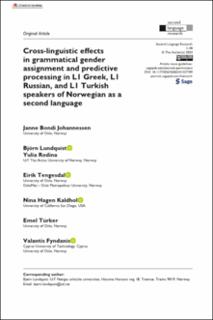| dc.contributor.author | Johannessen, Janne Bondi | |
| dc.contributor.author | Lundquist, Björn | |
| dc.contributor.author | Rodina, Yulia | |
| dc.contributor.author | Tengesdal, Eirik | |
| dc.contributor.author | Kaldhol, Nina Hagen | |
| dc.contributor.author | Türker, Emel | |
| dc.contributor.author | Fyndanis, Valantis | |
| dc.date.accessioned | 2024-04-10T05:23:41Z | |
| dc.date.available | 2024-04-10T05:23:41Z | |
| dc.date.created | 2024-03-21T13:15:17Z | |
| dc.date.issued | 2024 | |
| dc.identifier.issn | 0267-6583 | |
| dc.identifier.uri | https://hdl.handle.net/11250/3125593 | |
| dc.description.abstract | The present study examines grammatical gender knowledge in offline production (gender marking on indefinite articles) and online gender processing (visual world paradigm) in adult second language (L2) learners of Norwegian with three different first languages (L1s): Greek, Russian, and Turkish. In particular, it investigates the role of the following factors: (1) presence vs. absence of grammatical gender in L1 (Norwegian, Greek and Russian have gender, whereas Turkish does not), (2) lexical gender congruency, (3) structural similarity between L1 and L2 in the realization of gender, and (4) proficiency in L2. In offline production, no difference was found between the three L2 groups: they all overused the default gender (masculine). However, L1 effects were observed in the eye-tracking task, where the high-proficiency L1 Greek and L1 Russian speakers showed earlier and more prominent signs of predictive gender processing compared to the high-proficiency L1 Turkish speakers. There were no effects of lexical gender congruency or structural similarity. This suggests that, when it comes to predictive gender processing, what matters is proficiency and the presence vs. absence of grammatical gender in the L1. We interpret the findings in the context of current approaches to predictive processing emphasizing the role of cue reliability and utility. | en_US |
| dc.language.iso | eng | en_US |
| dc.rights | Navngivelse 4.0 Internasjonal | * |
| dc.rights.uri | http://creativecommons.org/licenses/by/4.0/deed.no | * |
| dc.title | Cross-linguistic effects in grammatical gender assignment and predictive processing in L1 Greek, L1 Russian, and L1 Turkish speakers of Norwegian as a second language | en_US |
| dc.type | Peer reviewed | en_US |
| dc.type | Journal article | en_US |
| dc.description.version | publishedVersion | en_US |
| cristin.ispublished | true | |
| cristin.fulltext | original | |
| cristin.qualitycode | 2 | |
| dc.identifier.doi | 10.1177/02676583241227709 | |
| dc.identifier.cristin | 2256400 | |
| dc.source.journal | Second Language Research | en_US |
| dc.relation.project | Norges forskningsråd: 223265 | en_US |
| dc.relation.project | Senter for grunnforskning: CAS 2019/20 MULTIGENDER | en_US |

